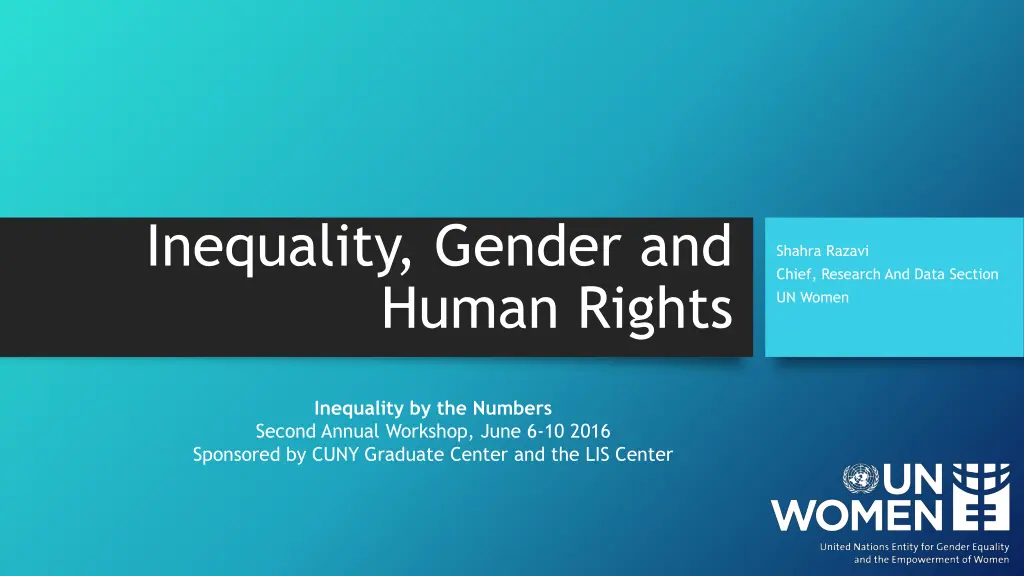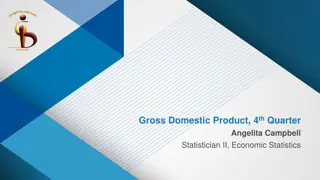
Gender Inequality in Income Distribution: A Critical Analysis
Explore the intersection of income inequality and gender in this insightful discussion led by Shahra Razavi. Gain a nuanced understanding of how women's earnings impact household income distribution and the broader economic landscape. Delve into factors contributing to the gender pay gap and the role of social norms in perpetuating inequality. Discover ways to address gender disparities for a more equitable society.
Download Presentation

Please find below an Image/Link to download the presentation.
The content on the website is provided AS IS for your information and personal use only. It may not be sold, licensed, or shared on other websites without obtaining consent from the author. If you encounter any issues during the download, it is possible that the publisher has removed the file from their server.
You are allowed to download the files provided on this website for personal or commercial use, subject to the condition that they are used lawfully. All files are the property of their respective owners.
The content on the website is provided AS IS for your information and personal use only. It may not be sold, licensed, or shared on other websites without obtaining consent from the author.
E N D
Presentation Transcript
Inequality, Gender and Human Rights Shahra Razavi Chief, Research And Data Section UN Women Inequality by the Numbers Second Annual Workshop, June 6-10 2016 Sponsored by CUNY Graduate Center and the LIS Center
Outline Income inequality and women s paid work: A view from the malestream How do women s earnings affect income inequality more broadly? Inequality from a gender perspective: Posing the question differently Gender inequalities in the economic domain: The right to paid work, a right for all? Gender inequalities in the economic domain: The role of social norms and the non-market sphere of care/social reproduction The gender pay gap: Trends and causes Accumulating socio-economic disadvantage: Gender gaps in lifetime income Towards a comprehensive framework: Substantive equality
Income inequality and womens paid work: A view from the malestream Gender is tangential to much of the literature on income inequality Main question asked (e.g. Atkinson 2015): How do women s earnings affect income inequality between households? Evidence from US for 1950-1970s: pay distribution getting wider (i.e. more unequal) BUT not accompanied by a commensurate rise in income inequality If the increase in female employment is concentrated among women living with low-earning men this could mitigate income inequality; but if among higher educated women co-habiting with higher earning men then income inequality could be exacerbated Evidence for USA provides different answers depending on time frame used (immediate post-war impact of female employment was equalizing versus post-1970s less so) The role of marital homogamy or assortive mating of higher educated women partnering with higher income men -- increases inequality across households (Esping-Andersen, 2007) BUT more complex picture based on cross-national evidence from 17 LIS countries (Harkness 2013)
Womens share of family earnings among middle-income couples and partners earnings correlations for all couples, around 2004 TABLE 1 MIDDLE-INCOME COUPLES ALL COUPLES Correlation of partners' earnings (couples with earnings > 0) Correlation of partners' earnings (both partners earnings > 0) Percentage of women earning more than their partner Correlation of partners' earnings (including couples with no earnings) Female earnings share (%) Anglo American Australia Canada Ireland United Kingdom United States Continental Europe Austria France Germany Luxembourg Netherlands Southern Europe Greece Italy Spain Nordic Countries Denmark Finland Norway Sweden Source: Harkness 2013. Author s calculations from the LIS database *p<0.1; **p <0.05. 37 33 40 37 32 27 25 34 26 23 0.166** 0.106** 0.077** 0.123** -0.034** -0.095** -0.002** -0.196** -0.079** -0.116** 0.133** 0.158** 0.111* 0.140** 0.030** 28 35 27 23 26 18 24 19 12 13 0.061** 0.175** -0.018* 0.102** 0.013 -0.103** 0.024 -0.143** -0.026 -0.125** 0.263** 0.301** 0.025* 0.323** 0.025* 30 30 26 24 24 20 0.224** 0.204** 0.176** -0.128** -0.102** -0.042** 0.460** 0.328** 0.361** 40 40 34 36 26 28 19 20 0.260** 0.227** 0.156** 0.263** 0.102** 0.041** 0.027** 0.150** 0.202** 0.238** 0.142** 0.224**
Income inequality under three counterfactuals, around 2004 TABLE 2 HALF-SQUARED COEFFICIENT OF VARIATION COUNTERFACTUAL WHERE: NO WOMEN WORK ALL WOMEN WORK NO GENDER PAY GAP Actual I2 Percentage change Percentage change Percentage change Country I2 I2 I2 Norway 0.122 0.179 47 0.088 -28 0.104 -15 Denmark 0.129 0.187 45 0.083 -36 0.133 3 Sweden 0.137 0.179 31 0.096 -30 0.116 -15 Finland 0.178 0.246 38 0.120 -33 0.191 7 Netherlands 0.188 0.259 38 0.138 -27 0.174 -7 Luxembourg 0.194 0.235 21 0.147 -24 0.168 -13 Austria 0.195 0.271 39 0.123 -37 0.171 -12 Germany 0.221 0.319 44 0.168 -24 0.212 -4 Australia 0.227 0.312 37 0.121 -47 0.206 -9 Canada 0.228 0.329 44 0.160 -30 0.196 -14 United Kingdom 0.244 0.373 53 0.164 -33 0.219 -10 France 0.245 0.344 40 0.159 -35 0.212 -13 United States 0.282 0.459 63 0.219 -22 0.279 -1 Spain 0.295 0.343 16 0.159 -46 0.257 -13 Ireland 0.301 0.440 46 0.166 -45 0.268 -11 Italy 0.383 0.478 25 0.144 -62 0.365 -5 Greece 0.459 0.550 20 0.184 -60 0.440 -4 Source: Harkness 2013. Author s calculations from the LIS database
Economic inequality from a gender perspective: Posing the question differently Turning around the question: What do gender equalities look like in the economic domain (rather than how does gender inequality contribute to class inequality)? What drives gender inequalities? At a time when women s access to education has converged if not surpassed men s, why have women s economic opportunities and earnings not converged with men s? Why has greater equality in the capability domain not been translated into equality in the livelihoods domain (Seguino 2013) The average percentage point gap between women s and men s labor force participation globally is 26 percent.
FIGURE 1 Gender inequalities in the economic domain: The right to paid work, a right for all? Labour force participation rate by sex and region, 1990-2013 Source: UN Women 2015, Figure 2.1. Note: Note: Regions are as follows: CEECA (Central and Eastern Europe and Central Asia); Developed (Developed Regions); EAP (East Asia and the Pacific); LAC (Latin America and the Caribbean); MENA (Middle East and North Africa); SA (South Asia); SSA (sub-Saharan Africa). See UN Women s regional groupings for the list of countries and territories included in each region in Annex 7.
Gender inequalities in the economic domain: The role of social norms and the non-market sphere of care/social reproduction FIGURE 2 Gender gaps in labour force participation rates by age group, 1990 and 2013 Source: UN Women 2015, Figure 2.2.
FIGURE 3 Time spent on unpaid work by sex, developing and developed countries, 2005-2013 Time use by sex and geographic region 35 30 25 10 10 10 (% TIME PER DAY) 20 16 19 21 15 10 19 19 18 5 10 8 5 0 M F M F M F Developing regions (30) Developed regions (29) blank space World (59) Total unpaid work Total paid work Source: Compilation of latest available Time Use Surveys (2000-2014), see Charmes (2015) for the full list of sources by country. Note: In the chart, M denotes Male and F denotes Female .
Average maternal employment rates by number of children in EU countries, clustered by family policy regime, 2013 FIGURE 4 Source: UN Women 2015. Note: Family policy regime classification as in Th venon 2011: 1. Limited assistance to families. 2. Long leave but low cash benefits and childcare for children under age 3. 3. Period of paid leave is short, with support targeted to low-income, single- parent families and families with preschool children. 4. High financial support but limited service provision to support dual-earner families with children under age 3. 5. Continuous, strong support for working parents of children under age 3.
FIGURE 5 Other dimensions of economic inequality by gender: The gender pay gap Unadjusted gender pay gap (GPG), 2000 and 2010 Source: UN Women 2015. Note: Wage data used for this analysis refers to mean earnings of employees, and includes remuneration made in cash and in-kind for time worked, work done and paid leave.
Gender pay gap: What it measures and what it means Gender pay gaps: the ratio of men s to women s earnings can be used to measure the gender pay gap. Income generated from self-employment, due to scarcity of data, is not included. Part-time employment is also not included. Hence, estimates likely to understate the gap. Globally women on average are paid 24 per cent less than men; regional averages vary from around 33 percent in South Asia to 14 percent in the Middle East Overall, gender pay gaps have narrowed slightly over the past decade, declining between 2000 and 2004 in 45 out of 50 countries for which data was available Also useful to ask HOW/WHY GPG has narrowed? In a few other countries GPG has narrowed in the context of rising wages for women and falling or stagnating wages for men (e.g. Austria, Honduras, Israel, Japan, Mexico and State of Palestine) In a few countries GPG has narrowed in the context of falling wages for both women and men, but more dramatic falls for men (e.g. Egypt, El Salvador, Hong Kong, Panama, Sri Lanka, and the UK)
FIGURE 6 Real wage trends and gender pay gap in the UK, 2003-2013 Source: UN Women 2016. Policy Brief No. 6.
Accumulating socio-economic disadvantage: Gender gaps in lifetime income Snapshot: gender gap in pay per hour, week or year Dynamic perspective: lifetime income Factors that shape it: gender gaps in LFP, pay, type of work (unpaid, informal), generosity of social transfers, levels of education and experience. Comparison of France, Germany, Sweden and Turkey Women s lifetime earnings were lower than men s by: 31% in France and Sweden 49% in Germany 75% in Turkey Main contributor to the gender gap in lifetime income: women s lower labor force participation rates (shaped by social norms, care practices); generosity of transfer systems a secondary contributor.
Reducing socioeconomic inequalities by gender Gender inequalities in labor force participation and gender pay gaps are not simply a reflection of lower human capital investments in women There are social and structural constraints that shape economic inequalities between women and men Social segmentation in the unpaid care economy and lack of accessible and affordable public care services contributes to gender inequalities in LFPR Labor markets themselves as social institutions also stratify labor: occupational segregation by gender slots women and men into different occupations and at different levels; occupational segregation remains persistent around the world and contributes to gender pay gaps To promote equal pay, reforms need to focus on three policy areas: Raising the wage floor Valuing women s work and skills (e.g. valuing female professions such as nursing and teaching) Affordable and quality care services (which requires at least partial public financing and regulation Paid parental leave policies (with positive incentives for men)
BUT substantive gender equality, or womens enjoyment of their human rights, includes three key dimensions: Socioeconomic equality or redistribution Equality of recognition, i.e. redressing stigma, stereotyping and violence Equality of voice, agency and participation (Fraser et al. 2004; Fredman 2011) This lecture has focused on socioeconomic equality and its social determinants and the need for redistribution Issues of mis-recognition go beyond the way in which discriminatory social norms and stereotypes shape labor markets and gender pay gaps; gender stereotypes, stigma and violence pervade public and private lives (some parallels with racial stigma, stereotype and violence) Gender inequalities in agency and voice also pervasive in both private and public life; economic resources can enhance agency and voice BUT there is also the need for collective voice to re-shape policies and regulations to reduce socioeconomic inequalities in access to resources (money, time, services, etc.). Ultimately, these three dimensions need to work in tandem to produce transformative change.
References Atkinson, Anthony B. (2015) Inequality: What Can Be Done? Harvard University Press, Cambridge, Massachusetts and London, England. Boris, Eileen and Fish, Jennifer N. 2014. Domestic workers go global: the birth of the International Domestic Workers Federation. New Labour Forum, Vol. 23, No. 3, pp. 76 81. http://nlf.sagepub.com/content/23/3/76.full (Accessed 16 February 2016.) Budig, Michelle and Joya Misra (2010). How care-work employment shapes earnings in cross-national perspective , International Labour Review, 149(4), pp.441-460. Elson, Diane (1999) Labor markets as gendered institutions: Equality, efficiency and empowerment issues , World Development 27(3): 611 27. Esping-Anderssen, Gosta. 2007. Sociological Explanations of Changing Income Distributions. The American Behavioral Scientist, 50 (5). Fraser, Nancy, Dahl, Hanne Marlene, Stoltz, Pauline and Willig, Rasmus. 2004. Redistribution, recognition and representation in capitalist global society: an interview with Nancy Fraser. Acta Sociologica, Vol. 47, No. 4, pp. 374 82. http://www.jstor.org/stable/4195051?seq=1#page_scan_tab_contents (Accessed 16 February 2016.) Fredman, Sandra. 2011. The potential and limits of an equal rights paradigm in addressing poverty. Stellenbosch Law Review, Vol. 22, No. 3, pp. 566 90. http://reference.sabinet.co.za/sa_epublication_article/ju_slr_v22_n3_a9 (Accessed 16 February 2016.) Harkness, Susan. 2013. Women s employment and household income inequality. Janet C. Gornick and Markus Jantti (eds), Income Inequality: Economic Disparities and the Middle Class in Affluent Countries. Redwood City CA, Stanford University Press, pp. 207 33. Kabeer, Naila. 2000. The Power to Choose. Bangladeshi Women and Labour Market Decisions in London and Dhaka. London and New York, Verso. Rubery, Jill. 2016. Tackling the Gender Pay Gap: From Individual Choices to Institutional Change. UN Women Policy Brief Series. No. 6. http://www.unwomen.org/en/digital-library/publications/2015/12/un-women-policy-brief-series Rubery, Jill and Grimshaw, Damian. 2015. The 40-year pursuit of equal pay: a case of constantly moving goalposts. Cambridge Journal of Economics, Vol. 39, No. 2, pp. 319 43. http://cje.oxfordjournals.org/content/39/2/319 (Accessed 16 February 2016.) Seguino, Stephanie. 2013. Toward gender justice: confronting stratification and unequal power. Generos Multidisciplinary Journal of Gender Studies, Vol. 2, No. 1, pp. 1 36. http://hipatiapress.com/hpjournals/index.php/generos/article/view/277 (Accessed 16 February 2016.) Seguino, Stephanie. 2007. Plus ca change: evidence on global trends in gender norms and stereotypes. Feminist Economics, Vol. 13, No. 2, pp. 1 28. https://www.uvm.edu/~sseguino/pdf/plus_ca_change.pdf (Accessed 22 February 2016.) Th venon, O. 2011. Family policies in OECD countries: a comparative analysis. Population and Development Review, Vol. 37, No. 1, pp. 57 87. http://www.vasa.abo.fi/users/minygard/Undervisning-filer/Th%C3%A9venon%202011.pdf (Accessed 16 February 2016.) United Nations Development Programme (UNDP). 2013. Humanity Divided: Confronting Inequality in Developing Countries. New York, UNDP. UN Women. 2015. Progress of the World s Women 2015/2016: Transforming Economies, Realizing Rights. New York, UN Women.






















